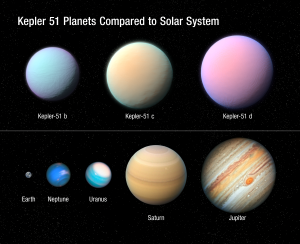Blog
Planet Super-Puff
21 December 2019
 NASA, ESA, and L. Hustak and J. Olmsted (STScI)
NASA, ESA, and L. Hustak and J. Olmsted (STScI)Earth is the densest planet in our solar system. Jokes about humanity’s intelligence aside, that makes sense because Earth is the largest of the rocky worlds. All of the terrestrial planets have densities around 4 - 5 g/cc. The planet with the lowest density is Saturn. Its density is so low that a planet of solid water or ice would be more dense. Again, that makes sense given that it is a gas planet. All the gas planets have densities around 1 g/cc. As astronomers have discovered planets around other stars, they have found that the density of a planet can be much lower. Some exoplanets have such low densities it’s difficult to understand how they exist.
Recently a team measured the density of three planets orbiting the star Kepler 51, and found they all have densities less than 0.1 g/cc. The largest of the three is as large as Jupiter, but has a mass of only 3 Earths. They have called these kinds of planets “super-puffs.”1
A planet with such extraordinarily low density shouldn’t be stable, so it is likely that these worlds are in transition. Kepler 51 is only about half a billion years old, which is quite young for a star system. One idea is that these worlds formed farther away from their star, beyond what is known as the “ice line.” They then migrated toward the star due to the gravitational dynamics of the system. Once closer to the star they would warm up, causing their icy outer region to expand.
When the team observed the spectra of these worlds, they expected to detect the presence of water and other volatiles, which would agree with the migration idea. But they didn’t find that. It’s likely that their atmospheres aren’t just cloudy, but are filled with particulates or a photochemical haze, similar to the atmosphere of Titan.
It’s possible that over time these worlds will settle down, and become planets similar to Neptune. But there could also be some yet undiscovered mechanism that keeps them in a puffy state. They are strange worlds, and it will take much more study to understand the mysteries they hold.
Libby-Roberts, Jessica E., et al. “The featureless transmission spectra of two super-puff planets.” arXiv preprint arXiv:1910.12988 (2019). ↩︎